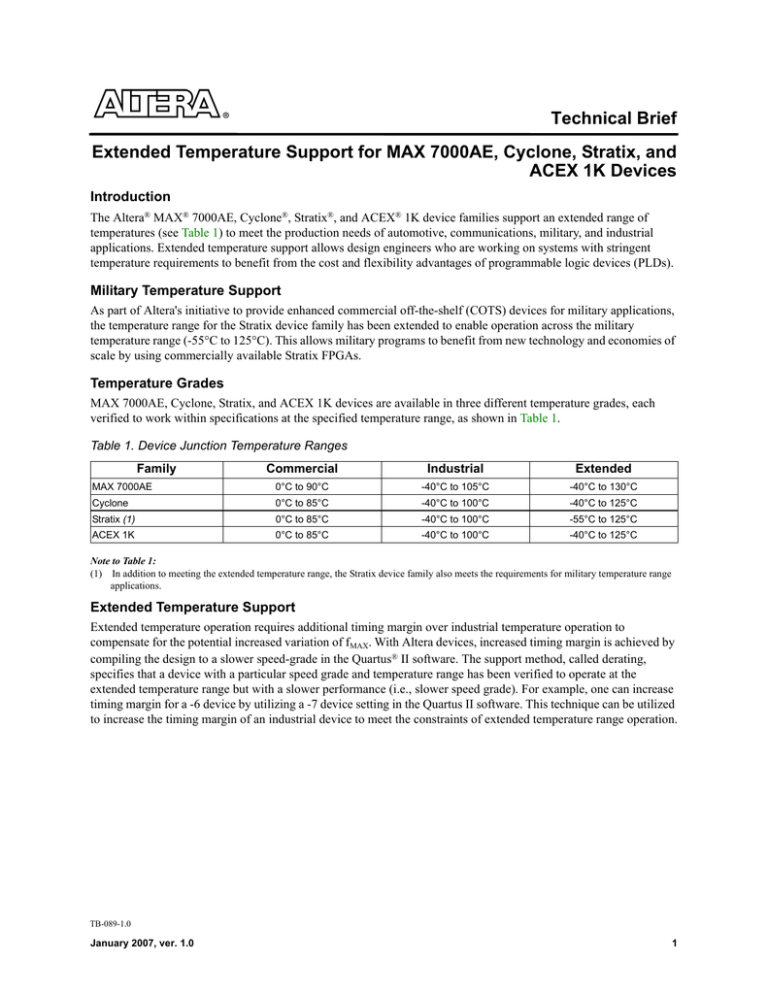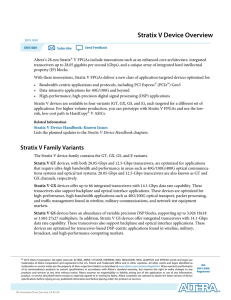
Technical Brief
Extended Temperature Support for MAX 7000AE, Cyclone, Stratix, and
ACEX 1K Devices
Introduction
The Altera® MAX® 7000AE, Cyclone®, Stratix®, and ACEX® 1K device families support an extended range of
temperatures (see Table 1) to meet the production needs of automotive, communications, military, and industrial
applications. Extended temperature support allows design engineers who are working on systems with stringent
temperature requirements to benefit from the cost and flexibility advantages of programmable logic devices (PLDs).
Military Temperature Support
As part of Altera's initiative to provide enhanced commercial off-the-shelf (COTS) devices for military applications,
the temperature range for the Stratix device family has been extended to enable operation across the military
temperature range (-55°C to 125°C). This allows military programs to benefit from new technology and economies of
scale by using commercially available Stratix FPGAs.
Temperature Grades
MAX 7000AE, Cyclone, Stratix, and ACEX 1K devices are available in three different temperature grades, each
verified to work within specifications at the specified temperature range, as shown in Table 1.
Table 1. Device Junction Temperature Ranges
Commercial
Industrial
Extended
MAX 7000AE
Family
0°C to 90°C
-40°C to 105°C
-40°C to 130°C
Cyclone
0°C to 85°C
-40°C to 100°C
-40°C to 125°C
Stratix (1)
0°C to 85°C
-40°C to 100°C
-55°C to 125°C
ACEX 1K
0°C to 85°C
-40°C to 100°C
-40°C to 125°C
Note to Table 1:
(1) In addition to meeting the extended temperature range, the Stratix device family also meets the requirements for military temperature range
applications.
Extended Temperature Support
Extended temperature operation requires additional timing margin over industrial temperature operation to
compensate for the potential increased variation of fMAX. With Altera devices, increased timing margin is achieved by
compiling the design to a slower speed-grade in the Quartus® II software. The support method, called derating,
specifies that a device with a particular speed grade and temperature range has been verified to operate at the
extended temperature range but with a slower performance (i.e., slower speed grade). For example, one can increase
timing margin for a -6 device by utilizing a -7 device setting in the Quartus II software. This technique can be utilized
to increase the timing margin of an industrial device to meet the constraints of extended temperature range operation.
TB-089-1.0
January 2007, ver. 1.0
1
Extended Temperature Support for MAX 7000AE, Cyclone, Stratix, and ACEX 1K Devices
Altera Corporation
Device Support
The device and package combinations shown in Table 2 support the extended temperature range.
Table 2. Extended Temperature Range Device Support
Family
MAX 7000AE
Cyclone (1), (2)
Stratix (3)
ACEX 1K (1)
Device
Package
EPM7032AE
44-pin thin quad flat pack (TQFP)
EPM7064AE
44-pin TQFP
100-pin TQFP
EPM7128AE
100-pin TQFP
144-pin TQFP
EPM7256AE
144-pin TQFP
256-pin FineLine BGA (FBGA)
EP1C3
144-pin TQFP
EP1C4
324-pin FBGA
EP1C6
144-pin TQFP
256-pin FBGA
EP1C12
256-pin FBGA
324-pin FBGA
EP1C20
400-pin FBGA
EP1S30
780-pin FBGA
EP1S40
780-pin FBGA
EP1S60
1020-pin FBGA
EP1K10
100-pin TQFP
EP1K30
144-pin TQFP
EP1K50
208-pin quad flat pack (QFP)
256-pin FBGA
EP1K100
208-pin QFP
256-pin FBGA
Notes to Table 2:
(1) The EPC1LI20 and EPC2LI20 configuration devices support configuration within the extended temperature range for ACEX 1K and Cyclone
devices. These configuration devices do not require derating.
(2) The EPCS1SI8 and EPCS4SI8 serial configuration devices support configuration within the extended temperature range for Cyclone devices.
These configuration devices do not require derating.
(3) The EP16UC88 configuration devices manufactured starting the second quarter of 2006 support configuration within the extended/military
temperature range for Stratix devices. These configuration devices do not require derating.
For MAX 7000AE devices, the extended temperature range devices are supported for -10 speed grade performance.
The -10 speed grade extended temperature range performance is achieved through derating of -7 speed grade
industrial devices (-I7).
For Cyclone devices, the extended temperature range devices are supported for -8 speed grade performance. The -8
speed grade extended temperature range performance is achieved through derating of -7 speed grade industrial
devices (-I7).
For Stratix devices, the extended/military temperature range devices are supported for -7 speed grade performance.
The -7 speed grade extended/military temperature range performance is achieved through derating of -6 speed grade
industrial devices (-I6).
For ACEX 1K devices, the extended temperature range devices are supported for -3 speed grade performance. The -3
speed grade extended temperature range performance is achieved through derating of -2 speed grade industrial
devices (-I2).
2
Altera Corporation
Extended Temperature Support for MAX 7000AE, Cyclone, Stratix, and ACEX 1K Devices
Software Support
When using extended temperature range devices, you must assign the slower commercial speed grade device in the
Quartus II software. The compilation result for these device and speed grades will show the worst-case timing for
your extended temperature range device. The software will generate the necessary programming file (e.g.,
Programmer Object File (.pof) or SRAM Object File (.sof)). To support this performance at the higher operating
temperature, the device ordered and shipped will be a - I7 (MAX 7000AE), - I7 (Cyclone), -I6 (Stratix), or - I2
(ACEX 1K). The slower speed grade commercial POF or SOF is compatible with their respective faster industrial
speed grade devices. See Table 3 for derating information.
Table 3. Derating for Extended Temperature Families
Speed Grade of Device to Order
Speed Grade of Device to Select
in the Quartus II Software
MAX 7000AE
-I7
-C10
Cyclone
-I7
-C8
Stratix
-I6
-C7
ACEX 1K
-I2
-C3
Family
Table 4 shows the Quartus II software target device along with the corresponding faster industrial device ordered.
Table 4. Extended Temperature Range Device Software Selection
Family
MAX 7000AE
Cyclone
Stratix
ACEX 1K
Industrial Device Ordered & Shipped
Device Selected in Software
EPM7032AETI44-7
EPM7032AETC44-10
EPM7064AETI44-7
EPM7064AETC44-10
EPM7064AETI100-7
EPM7064AETC100-10
EPM7128AETI100-7
EPM7128AETC100-10
EPM7128AETI144-7
EPM7128AETC144-10
EPM7256AETI144-7
EPM7256AETC144-10
EPM7256AEFI256-7
EPM7256AEFC256-10
EP1C3T144I7
EP1C3T144C8
EP1C4F324I7
EP1C4F324C8
EP1C6T144I7
EP1C6T144C8
EP1C6F256I7
EP1C6F256C8
EP1C12F256I7
EP1C12F256C8
EP1C12F324I7
EP1C12F324C8
EP1C20F400I7
EP1C20F400C8
EP1S30F780I6
EP1S30F780C7
EP1S40F780I6
EP1S40F780C7
EP1S60F1020I6
EP1S60F1020C7
EP1K10TI100-2
EP1K10TC100-3
EP1K30TI144-2
EP1K30TC144-3
EP1K50QI208-2
EP1K50QC208-3
EP1K50FI256-2
EP1K50FC256-3
EP1K100QI208-2
EP1K100QC208-3
EP1K100FI256-2
EP1K100FC256-3
Testing
Semiconductor devices undergo at least two types of testing: device characterization and production testing. Device
characterization is used to verify the performance of a semiconductor design and its physical implementation.
Production testing is used to find manufacturing defects that randomly occur during the manufacture of all
3
Extended Temperature Support for MAX 7000AE, Cyclone, Stratix, and ACEX 1K Devices
Altera Corporation
semiconductor devices. This section of the white paper describes these testing methods and the roles they play in
supporting extended temperature MAX 7000AE, Cyclone, Stratix, and ACEX 1K devices.
Device characterization is performed on a small sample of devices to characterize performance and performance
variations across process, voltage, and temperature changes. Once device characterization has been performed, the
operation of the device is well understood across a variety of operating conditions including commercial, industrial,
and extended temperatures. Device characterization allows Altera to determine if a product can be utilized in
commercial, industrial, and extended temperature conditions.
Production testing is used to identify manufacturing defects in devices prior to shipment to customers. There are two
key stages for production testing: wafer sort and post device assembly (packaging). Wafer sort identifies good dies,
which continue in the manufacturing process to device assembly. After assembly, additional testing is performed to
verify device functionality and determine performance binning (speed and temperature grades).
Altera has characterized these devices across the commercial, industrial, and extended temperature ranges, and
verified that they perform within our stringent specifications. However, note that while commercial-grade devices
have been production tested and screened at commercial temperatures, and industrial-grade devices have been
production tested and screened at the industrial high-end temperatures, Altera does not perform production screening
for extended temperature operation.
Conclusion
Altera supports extended temperature range MAX 7000AE, Cyclone, Stratix, and ACEX 1K devices in the Quartus II
software through a derating strategy enabling customers to target their designs for automotive, communications,
military, and industrial applications.
101 Innovation Drive
San Jose, CA 95134
(408) 544-7000
http://www.altera.com
4
Copyright © 2007 Altera Corporation. All rights reserved. Altera, The Programmable Solutions Company, the stylized Altera logo, specific device
designations, and all other words and logos that are identified as trademarks and/or service marks are, unless noted otherwise, the trademarks and service
marks of Altera Corporation in the U.S. and other countries. All other product or service names are the property of their respective holders. Altera products
are protected under numerous U.S. and foreign patents and pending applications, maskwork rights, and copyrights. Altera warrants performance of its
semiconductor products to current specifications in accordance with Altera's standard warranty, but reserves the right to make changes to any products and
services at any time without notice. Altera assumes no responsibility or liability arising out of the application or use of any information, product, or service
described herein except as expressly agreed to in writing by Altera Corporation. Altera customers are advised to obtain the latest version of device
specifications before relying on any published information and before placing orders for products or services.


